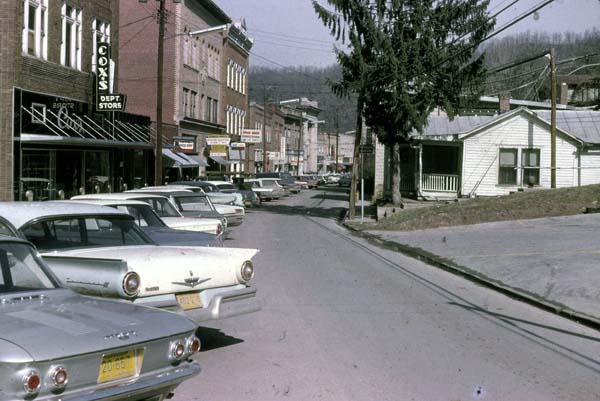Growing up in Madison
“I wouldn’t trade it for any other time”
By John A. Hunter Jr.

Main Street in 1964, at the peak of Madison’s glory years. Courtesy of Eric Jon White.
I’ll never forget my childhood home in the Hospital Bottom, a low-lying stretch of land along the banks of the Spruce Fork and Little Coal rivers, about a mile south of downtown Madison. Route 119 South ran along its upper border. The old Boone County Hospital stood in that area before Boone Memorial opened in 1964. My dad built our house around 1957, and I lived there while attending Madison Grade School.
The best thing about the Hospital Bottom was the sense of family and community. It was hard to be a stranger back then; most families had known one another for generations. My mother’s sister Joann lived next door. My dad’s sister Bobbi and my cousin Nicky lived only a few hundred yards down the road.
Living in the Hospital Bottom meant you always had a friend to play with. Nearly every family had children, so we played outside on weekends and during the summer from sunrise to bedtime. Most daytime activities revolved around sports, which rotated based on the season: baseball in the spring, Wiffle ball in the summer, and football in the fall. We played year-round outdoor basketball pretty much regardless of the weather. In winter, we’d shovel snow off the courts and play frenzied games, even though our hands and fingers were freezing. In the evenings, we played a game called Indian Trapper, where you tackled a boy on the other team and held him captive until his teammates came to the rescue. We’d play in vacant, grassy fields until our parents made us come in to take a bath and get ready for bed. By then, our legs were aching, and we were covered with grass stains from head to toe. Many nights, I soaked in a hot bathtub as my legs throbbed and stung from cuts and scrapes sustained during the day’s activities. We’d go to bed tired and sore, get up early the next morning, and do it all over again.
When I was young, my father would take us to Ray Smoot’s Grocery every Saturday night. My brother, sister, and I would get to pick out a treat. Ray had a big, glass, well-stocked candy counter. He had about every candy bar made back then: Baby Ruths, Mars bars, Almond Joys, Hershey bars (with and without almonds), Zagnuts, and many, many more.
There were also boxes of individually wrapped baseball cards. Baseball cards were only a penny and came with a sheet of bubble gum the size of the card itself. We never got any change back at Ray’s because we’d spend all our leftover candy money on cards. Every boy collected cards and kept them in tall stacks wrapped with thick rubber bands. Every time you unwrapped a new card, you’d close your eyes, hold your breath for a second, and hope you’d get one of your favorite players. The best ones—Mickey Mantle, Willie Mays, Roberto Clemente, Hank Aaron—were hard to find. Once, after getting a Roger Maris card, I got so excited telling Nicky that I woke up Granddad Hunter from his sleep and got reprimanded. That was in 1961, when Maris outpaced Mantle to break the single-season Major League home run record. That year, we all pretended to be Maris or Mantle when we went to bat in after-school games.
We’d often ride our bikes to Ray’s and park in front of his store. It was common to see 10 or more bikes there on a Saturday afternoon. Unlike today, almost all bikes back then were one speed and American made. Very few kids had what we called “three-speed English bikes.” There weren’t any 10- or 15-speeds, so climbing a steep hill was arduous; you usually had to get off your bike and push it the rest of the way once you ran out of steam. We liked to compare our bikes to see who had the coolest one. Headlights—powered by either batteries or wheel generators—set some apart from others. Another thing I remember is attaching squirrel tails to our handlebars during hunting season.
You can read the rest of this article in this issue of Goldenseal, available in bookstores, libraries or direct from Goldenseal.